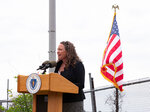







A team of state and federal officials last week assembled along the harbor behind Town Hall to announce $1.5 million in coastal resiliency funding to support next year’s restoration and expansion of Manchester’s Central Street culvert and restoration of Sawmill Brook areas in the critical areas along Elm Street, School Street and lower Brook Street.
It was a relatively small gathering next to the Central Street culvert, belying the extensive spectrum of officials present.
Select Board Chairman Ann Harrison said success with this grant was critical for the future of Manchester’s resilience posture. The project has been sorely needed, said Harrison, “for decades.”
She was joined by Town Administrator Greg Federspiel, DPW’s Chuck Dam and Nate Desrosiers, Harbormaster Bion Pike, ConCom officials along with state and federal agency officials that included MA Secretary for Energy and Environmental Affairs Rebecca Tepper (EEA); Lisa Berry Engler, director at the Massachusetts office of the National Coastal Zone Management (CZM); and Betsy Nicholson, north regional director of NOAA, the US Office of Coastal Management, among others. MA Representative Ann Margaret Ferrante and MA Senator Bruce Tarr were also on hand.
The $1.5 million restoration grant will be combined with an additional $4.5 million in US FEMA “BRIC” (Building Resilient Infrastructure and Communities) grant to pay for the nearly $7 million project. Local and state funds will cover the balance of the project’s costs.
Ferrante invoked dramatic images of haze that have blanketed the East Coast in recent weeks from Canadian wildfires to the north. She said the impacts of climate change are here, illustrating that we are all connected. They also demonstrate the urgency of projects like this one.
The US CZM’s Nicholson said Thursday the grant monies are part of the US Dept of Commerce’s effort to help coastal communities fortify infrastructure in the face of changing climate conditions with funding and technical assistance for capacity building, transformational projects that help protect communities from storms and flooding. The grant won by Manchester is one of two announced last week. The other recipient is the town of Truro, on Cape Cod.
Nicholson credited Manchester Town Administrator Greg Federspiel’s “tenacity” and pointed to the town’s diligent engineering research work over the last nine years that documented the critical nature of the Central Street culvert for making the town a strong candidate for millions in grant funding. No data, no funding, she said.
Sen. Bruce Tarr agreed, adding that the Central Street dam and culvert aren’t just about connecting one part of Manchester to another. It also houses critical underground electrical utility infrastructure lines that feed the rest of Cape Ann, making this relatively small culvert particularly important. He said the disruption would be significant if it were to fail unexpectedly, and the impact would go beyond Manchester. Not to mention the inability of emergency vehicles to pass directly from one end of town to the other.
And it’s true. For the past few years, a considerable amount of study and analysis has been conducted of the dam and culvert that crosses over Sawmill Brook as it empties into the inner harbor. There is also the upstream dynamics, including the tidal pond behind the Fire Station on School Street.
Work to repair, slightly expand, and update the dam and culvert is expected to begin in Fall 2024.
The six to nine-month construction project requires cutting off Central Street to vehicle traffic for various periods. A walking bridge will be installed for foot traffic, said DPW Director Chuck Dam. It will be an inconvenience to residents and businesses in the immediate area, for sure, but it’s necessary.
Officials Thursday acknowledged Harbormaster Bion Pike, who has actively secured state grant funding for coastal infrastructure projects tied to economic development. In 2018, state grants were pivotal in the multimillion restoration of Morss Pier at Masconomo Park, Manchester’s commercial fishing dock infrastructure.
This area is within the FEMA 50-year flood zone, which impacts the Manchester village area, including the buildings on either side of Elm Street, those behind School Street, and along the base of Brook Street (before Norwood Avenue).
The brook has caused flood damage in past storms, and the old dam and stone culvert (last reconstructed in 1900), which restricts water flow, is in poor condition. The Massachusetts Dept of Transportation’s most recent inspections of the culvert classified it as having a “severe/major deficiency” that is urgent and should be addressed.
The DPW's Chuck Dam said a larger culvert would help prevent flooding upstream during significant rain events.
The new culvert will be built to today’s engineering and construction standards. A stone façade will replicate the look of the original structure.
The construction of the new structures will be challenging, given the small space to work in and the utility lines crossing at this location. Besides the major electrical feed for Cape Ann, other utilities pass under the culvert (but aren’t expected to be a factor during construction). They include a National Grid gas pipeline, Comcast/Verizon ducts, and the municipal sewer main.
The project also includes work upstream. The retaining walls along the east side of Central Pond are in poor condition, with stretches of the old wall falling into the brook. These walls will be rebuilt, and the brook will be restored to its natural state with salt marsh grasses reestablished in the current mudflats.
According to Federspiel, the banks on the west side will be fortified with “living shorelines” to protect it from further erosion while maintaining the natural look.
The brook serves as spawning habitat for endangered rainbow smelt and American eel. Removing the tide gate and restoring the brook to its natural state will have the added benefit of improving this habitat.
With grant funding (national and state) underwriting nearly the entire $6 million bill, Sec. Tepper said funding is about more than habitat. She said the state is laser-focused on supporting coastal communities like Manchester that are on the front line of climate change and facing these threats.